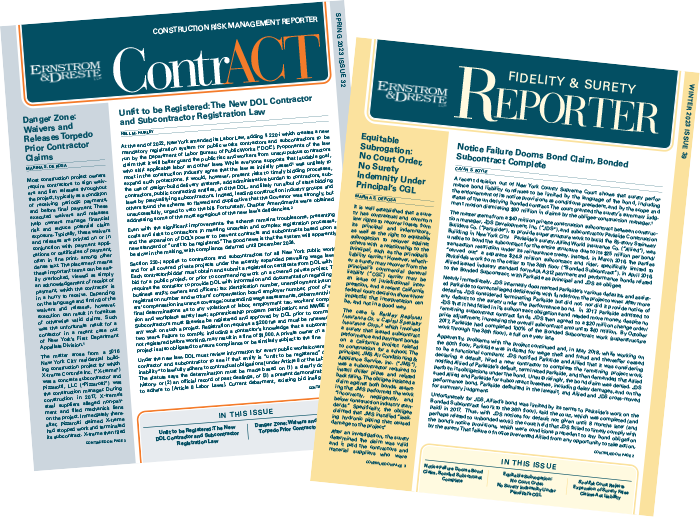Article by: Cavan S. Boyle
The Amendment to New York Penal Law § 20.20, known as Carlos’ Law, became effective in March, following the death of Carlos Moncoya, a 22-year-old worker killed in a 2015 trench collapse. Legislators sought to raise financial penalties for corporate criminal conduct like that in Carlos’ case, where the fine was a mere $10,000. Thus, the heart of Carlos’ Law is not so much a change to liability as it is a steep increase in fines permitted when a company is found criminally responsible for employee injuries or deaths. Fine caps were raised from $10,000 to $500,000 for felonies and from $5,000 to $300,000 for misdemeanors. The amendment, however, made other changes to know about.
A corporation is guilty under Carlos’ Law when its agent, while acting within the scope of his employment, commits an offense that involves the death or serious physical injury of an employee where the corporation acted negligently, recklessly, intentionally or knowingly. “Agent” is an expansive term, though not new under the amendment, and includes any person who is authorized on behalf of the corporation/employer to direct someone else’s actions.
The new law redefines the injured person from a “worker” to an “employee” apparently requiring that the person be employed by the corporation accused of the criminal conduct. This should help limit criminal liability to the direct employer, rather than potentially expanding contractor liability to all workers on a project.1 In addition, “employee” is defined broadly per the statute to include, in effect, all who are paid by a business or private party (the corporation-employer), regardless of exact label or employment details.
Carlos’ Law applies only to offenses that cause death or “serious physical injury,”2 requiring a substantial risk of death, serious disfigurement, serious health impairments, or the loss of the function of a bodily organ. The law does not cover serious injury to mental health.
Under the new law, a corporation-employer acts criminally if it “acts negligently, recklessly, intentionally, or knowingly.” Allegations of negligence or recklessness are the most common. Courts explain this distinction between them: recklessness requires the contractor to be aware of and consciously disregard a substantial unjustifiable risk, while criminal negligence occurs when a contractor fails to perceive such risk.
Prosecutor’s offices continue to have all tools available under New York’s Penal Law, not just Carlos’ Law, but some worry the increased fines (which go to the State) will be used to more aggressively investigate and prosecute jobsite criminal violations. In light of these risks, what can a contractor do to increase worker safety and minimize its potential criminal liability? Construction industry leaders agree that this likely includes actions contractors are already taking, or should be, but “more and better.”
1. Set the Tone: Leadership must set clear expectations at the beginning of the job: employee safety is the ultimate priority and cutting corners at the expense of safe work sites will not be tolerated.
2. Communicate: Consistent, effective communication and documentation regarding all things safety-related is imperative. Use direct channels of communication between each level of project management to avoid conflicting guidance and job site confusion on safety policy, implementation and practice.
3. Document: Keep accurate logs and sign in sheets to show which of your employees are on the job every day. Prepare safety incident reports to thoroughly document all violations and record the resolution to each incident, identifying each step taken.
4. Discipline: Safety violations by employees must be disciplined, providing incremental consequences where conduct reoccurs. Such discipline both corrects the wrong and creates evidence demonstrating the company’s compliance with Carlos’ Law, and other safety laws.
5. Sub Safety: Where subcontractors or their employees violate safety rules, notify the sub in writing and consider using a back charge. This documents company efforts to correct the violations, and provides incentive for subcontractor-employers to swiftly correct their safety violations.
6. Have a Plan: If there is a death or serious injury on a job, an emergency plan should be in place for securing the area, notifications, investigations, reports, response to police or District Attorney, and a possible press release.
Unlike some types of liability, a contractor cannot “contract away” the criminal liability set forth in Carlos’ Law.3 Fortunately, criminal prosecutions against contractors for workplace deaths and injuries are fairly uncommon. But the construction industry is inherently dangerous, and the new law serves as a meaningful reminder that worker safety must be paramount.
- Even so, liability has continued to be extended to upstream parties for civil liability through such means as the Wage Theft Act, and it is likely the aim of those enforcing Carlos’ Law to impose criminal liability whenever they possibly can.
- Prior law stated “injury.”
- It may, however, be possible to expand such potential liability contractually or by otherwise taking on additional responsibility for safety obligations.




